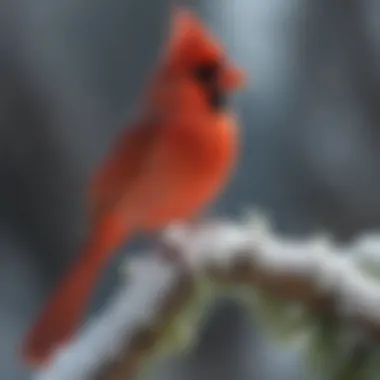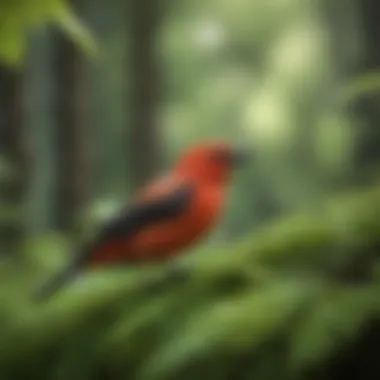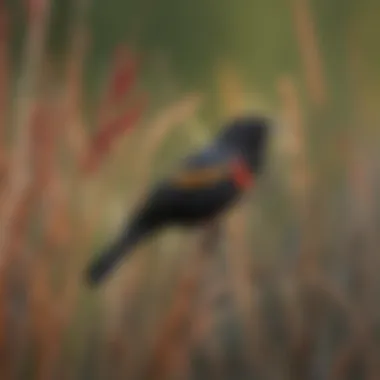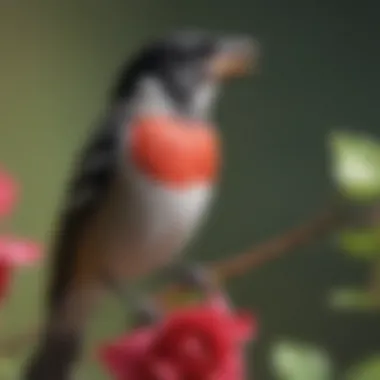Exploring the Vibrant Ecology of Red Birds


Animal Species Profile
Prelims to the Animal Species
Red birds are a myriad group exuding vivid colors and captivating behaviors. They have become well-known among both casual birdwatchers and experienced ornithologists. With vibrant plumage, they not only sprinkle the landscape with bright colors but also play pivotal roles in their ecosystems.
The different species of red birds include the Cardinal, Robins, Scarlet Tanager, and many others. Each has unique characteristics and contributes to its habitat in public and subtle ways. By delving into their traits, behaviors, and environments, we can better appreciate their ecological significance.
Physical Characteristics and Appearance
Distinctive red plumage is a hallmark of many popular species. For instance, the Northern Cardinal is known for its bold red coloration with a black face mask. Moreover, its distinctive crest can easily be spotted even at a distance. Red birds typically exhibit sexual dimorphism, meaning the males often are more vibrant than females. The bright colors facilitate mating rituals and play an essential role in territory acknowledgment.
Natural Habitat and Distribution
Red birds inhabit diverse climates, from tropical forests to temperate woodlands and grasslands. Their adaptability allows them to thrive across a wide geographic range. For example, the House Finch is often seen in urban areas, whereas the Red-headed Woodpecker prefers forests. This varied distribution emphasizes their resilience to changing environments, although habitats like wetlands are crucial for certain species.
Behavior and Social Interactions
The social interactions of red birds vary across species. Cardinals are notably territorial, established through vigorous singing and displays. On the other hand, House Finches often gather in flocks, which assists in foraging and predator avoidance. Communication among these birds largely involves intricate songs and visual signals, enriching their complex social lives.
Red birds display striking behaviors and adapt under varying environmental pressures, showcasing their versatility.
Conservation & Wildlife Efforts
Overview of Conservation Status
Many red bird species face declining populations due to habitat loss and climate change. The International Union for Conservation of Nature (IUCN) monitors these statuses, leading to improved conservation practices and laws.
Threats to the Species
Key threats include habitat destruction from urban expansion and agriculture. Climate change has also strained the living conditions of these birds, affecting their breeding patterns and food resources. Another issue is predation from domestic animals, which impacts ground-nesting species.
Conservation Initiatives and Organizations
Several organizations focus on the conservation of red birds. The National Audubon Society works tirelessly to protect essential bird habitats. Additionally, many community initiatives emphasize habitat restoration and public education, drawing attention to the plight of these fascinating creatures.
Success Stories and Impact
North American recovery efforts like the Eastern Bluebird brought once-nearly extinct populations back to healthier numbers. Such successes showcase the impact of concerted efforts and public participation.
Unique Facts & Trivia
Little-Known Facts About the Animal
- Red birds can often see different wavelengths of light compared to humans.
- Male robins have more colorful feathers during the breeding season.
- Many species shift their diets seasonally, which helps them survive.
Surprising Behaviors or Adaptations
Some red birds exhibit scraper behaviors. For example, Northern Cardinals engage in scratching to unearth insects during foraging.
Fun Trivia and Quirky Behaviors
Certain species sing differently based on regional acoustics, allowing for distinct dialects among populations.
Record-Breaking Feats or Abilities
Remarkably, the wandering red bird has been noted to travel up to 500 miles in a single day during migration.
Pet Care & Tips
Although some may desire red birds as pets, it's crucial to understand such commitment.
Choosing the Right Pet for Your Lifestyle
For pet seekers, interested in red birds suggest considering the species' care needs and adaptability in a captive environment. Species like the Society Finch offer a more manageable care routine.


Basic Care Requirements and Habitat Setup
Providing appropriate cage space, diet consisting of seeds or fruits, and enriched spaces contribute to good mental health for captured birds.
Health and Wellness Tips for Pet Longevity
Regular check-ups with an avian veterinarian ensure these pets live long, happy lives. Balanced diets high in vitamins, notably vitamin A, are vital for overall health.
Training Techniques and Behavioral Enrichment Ideas
Birds can be trained with positive reinforcement. Engaging activities such as puzzles or interaction can significantly enrich their lives.
Maintaining a focus on ecology, conservation, and proper care fulfills the passionately engaged reader's expectations and knowledge areas.
Intro to Red Birds
Red birds have a unique place in the avian world. As they possess striking colors and diverse behaviors, they capture the attention of both casual observers and dedicated birdwatchers. Studying red birds promotes understanding of ecological systems and assists in wildlife conservation.
Defining Red Birds
Red birds are a broad category encompassing numerous species that display vibrant red feathers. This coloration can be attributed to a variety of genetic, dietary, and environmental factors. The most notable examples include the Northern Cardinal, scarlet tanager, and the crimson-collared grosbeak. Defining these birds requires more than just color; identifying their habitat, behaviors, and adaptations is crucial. While some species range across large territories, others can be very localized in their habitats, showing diverse ecological interactions.
When observing red birds, one may notice variations in shade across species. Some are a bright crimson, while others exhibit a more muted red. Such differences play an important role in mating displays and territorial behaviors. Understanding these complexities in definition enriches our appreciation for red birds.
Ecological Importance of Coloration
The coloration of red birds serves important ecological functions. For many species, bright colors are crucial for mating success as vibrant hues often attract potential partners. Moreover, coloration can signal dominance during territorial fights. Bright red feathers project strength and fitness, essential traits for reproductive success.
In addition to mate attraction, the vibrant colors can also impact social dynamics within bird communities. For instance, social hierarchies may be partially defined by visual signaling that these colors provide. A male cardinal’s red plumage can signify its health and vitality, affecting its standing among other birds in the area.
Furthermore, the red pigmentation can play a role in predation and camouflage. Certain shades may help them blend into specific environments, thereby lowering the chances of being spotted by predators. This interplay between extinction and survival reveals a noteworthy utility of color in red birds and their ecological niches.
In understanding the nuances of red bird coloration, wildlife enthusiasts uncover deeper insights into avian behavior, which may lend itself to better conservation strategies.
Diversity of Red Birds
The notion of diversity within the avian world is vital for understanding the intricate web of life. Red birds represent a color grouping that embodies both commonness and rarity in various habitats. This richness in diversity allows study of ecological roles, adaptive strategies, and the implications of environmental shifts. By exploring this variation, one gains insights not only into red birds themselves but also into broader ecological principles.
Common Species Notable for Their Red Coloration
When considering common red bird species, a few stand out prominently across different regions.
- Northern Cardinal: Widely celebrated in North America, the male Northern Cardinal showcases a striking red plumage. Its cheerful song adds to its popularity amidst bird watchers.
- Scotch Finch: Known for its vibrant red chest, the Scotch Finch frequents open fields and is a frequent visitor to gardens.
- House Finch: Adaptable and often seen in urban settings, the House Finch boasts male birds with a reddish appeal.
These species illustrate the visibility of red birds in familiar landscapes, enhancing the appreciation for their role within ecosystems. Their ubiquity caters to the educational aspect of birdwatching, as they can often be seen in backyards or parks. Observing their behavior aids in understanding the relationship between species and their environments.
Exotic Red Birds Around the World
The allure of red birds extends far beyond local species. Various exotic birds capture the imagination with their unique adaptations and striking coloration.
- Scarlet Macaw: This Central American bird features radiant red plumage accented with blue and yellow. Its intelligence and social behavior make it a marvel.
- Greater Bird-of-Paradise: Native to New Guinea, this species exemplifies extreme sexual dimorphism with its brilliant yellow and red breasts, and elaborate courtship displays.
- Red-billed Quelea: Found in Africa, this small, agile bird forms enormous flocks, which creates a mesmerizing spectacle of moving color across the sky.
Each exotic red bird presents distinct behavioral patterns and ecological requirements, enriching our understanding of avian life globally. Their roles in their respective ecosystems provide essential insights into biodiversity and the impacts of environmental changes.
Habitats of Red Birds
The habitats of red birds play a vital role in understanding their behavior and survival. The variety of environments they inhabit contributes significantly to their adaptability and the diverse behaviors we observe within these species. Recognizing these habitats helps to highlight the keys aspects of ecological balance and the intricate relationships red birds have with their surroundings.
Mountainous Regions
Mountainous regions are often marked by a range of climates and vegetation types. In these environments, certain red bird species have developed unique adaptations. For example, the Sumatran Red-Billed Multatuli thrives above 1,500 meters, where it finds a suitable microclimate and food sources such as insects and berries. The challenges include steep terrains and changes in weather, yet these birds exhibit remarkable agility.
Their presence in mountain ecosystems is important for seed dispersal, as they contribute to the growth of plant species adapted to these heights. Consequently, the health of these mountainous habitats directly influences the populations of red birds that inhabit them.
Forests and Woodlands


Forests and woodlands are arguably the most common habitats for red birds. These areas provide abundant resources for feeding, nesting, and protection. Species like the Cardinalis cardinalis, known as the Northern Cardinal, are emblematic of U.S. woodlands. They prefer shrubby areas where they can forage for seeds and berries while having cover from predators.
The intricate ecosystems in forests allow red birds to interact with numerous other species, contributing to biological diversity. The lush foliage also suggests a focus on breeding. Their vibrant mating rituals often occur in tree canopies, which are important for territorial claims.
Similarly, dead and decaying trees serve as valuable habitats for insects, attracting red birds that provide essential insect control. Keeping forests intact is crucial, as degradation impairs these essential functions critical to both birds and surrounding wildlife.
Urban Environments
Urban environments present a different take on the habitat of red birds. Many species have learned to adapt to city living by using buildings and parks as nesting sites. The House Finch, for instance, thrives in urban habitats where it has access to a diverse range of food options, including human refuse, seeds from outdoor plants, and insects.
The adaptability of red birds in urban settings raises awareness of conservation biotechnology and urban planning. Bird-friendly designs in urban architecture not only support avian life but foster biodiversity in often barren city landscapes. Recognizing this, it's crucial for city planners to include green spaces and nesting opportunities in their development projects.
Fact: Urban gardens, community parks, and green rooftops serve as bridging gaps between red birds and their natural habitats, thereby promoting biodiversity.
In summary, understanding the habitats of red birds is crucial, as they directly intersect with our actions and choices about land use and conservation. Adopting measures that safeguard these environments is vital for the continued survival of red bird populations. These insights also drive home the necessity of habitat restoration efforts that ensure the future of red birds, both in nature and within urban sceneries.
Behavioral Patterns of Red Birds
The study of behavioral patterns among red birds offers critical insights into their adaptation, survival, and social structures. These behaviors play key roles in their ecology and serve to inform conservation strategies. Understanding how red birds act can enrich our knowledge about the biodiversity in our ecosystems as well as underline their importance in the natural world.
Feeding Habits
Red birds have diverse feeding habits that can vary significantly among species. For example, the cardinals typically feed on seeds, fruits, and insects, utilizing their strong beaks to crack open tough seeds. Meanwhile, the scarlet tanager adopts a different approach, being primarily an insectivore during the breeding season. Red birds generally possess feeder preferences based on their physical characteristics and regional availability of food.
Key Aspects:
- Diet Composition: It is essential to note that these habits can be influenced by habitat.
- Foraging Behavior: Many species exhibit different foraging strategies, such as ground foraging or feeding from tree canopies. Understanding these patterns provides insights into their ecological roles.
Mating Rituals
Mating rituals among red birds can vary widely, but they often include distinct and vibrant displays. For instance, red cardinals usually participate in elaborate courtship behaviors that include singing, a practice vital for attracting mates and marking territory. These avian performances demonstrate good health and virility to potential partners.
Important Considerations:
- Territoriality: Males often defend their territory with vocalizations and physical posturing to deter rivals during the breeding season.
- Nesting Strategies: After successful mating, construction of the nest becomes vital. The material choice and location influence the chances of reproductive success. Red birds usually favor dense foliage to provide concealing protection from predators.
Migration Patterns
Migration patterns in red birds highlight the adaptability and resilience of these species. For instance, many North American red birds migrate south for the winter to find more abundant food sources. The journey often requires tremendous energy and navigational precision.
Key Insights:
- Seasonal Movements: Understanding these seasonal movements helps in tracking changes in populations over time.
- Environmental Influences: Changes in habitat or climate patterns can impact migration routes, making this study essential for conservationists.
Conservation Challenges
Conservation of red birds is crucial for maintaining biodiversity. These birds, often seen as indicators of ecological health, face numerous challenges. Understanding these challenges offers insight into the responsibilities we share for their survival.
Threats to Red Bird Populations
Red birds are under threat from multiple sources. These include:
- Urbanization: Expansion of cities leads to habitat fragmentation. Many red species struggle to adapt to altered landscapes.
- Hunting: Some cultures engage in hunting red birds for sport or food. This adds direct pressure on their populations.
- Invasive Species: Non-native plants and animals may compete with red birds for resources, often diminishing their feeding and nesting options.
Recognition of these threats is the first step in preservation efforts.
Role of Habitat Loss
Habitat loss is a significant factor impacting red bird populations. Destruction of forests, wetlands, and grasslands removes shelter and feeding grounds. As these environments vanish, so do the many microhabitats within, which are critical for their survival. Additionally, loss of specific plant species directly affects the availability of food: many red birds depend on native plants for seeds and insects.
This loss can drive continued decline in diversity among red birds. Altogether, the degradation of their natural habitats forces many species towards extinction.
Climate Change Impacts
Climate change reshapes the environments red birds inhabit. As temperatures rise, some habitats become uninhabitable, leading birds to migrate to cooler areas. The following impacts reveal the dangers:


- Temperature Extremes: Red birds may experience increased stress from heat and cold, leading to changes in migration patterns.
- Food Availability: Altered weather patterns may disrupt seasonal behaviors, impacting food supply for these birds.
- Rising Sea Levels: For coastal species, increased water levels can destroy critical nesting habitats, pushing them further into decline.
Several studies predict that red birds will face drastic shifts in population if climatic conditions refuse to stabilize.
Addressing climate change is paramount for effective conservation strategy. Each of these challenges necessitates ongoing attention and action from informed communities and decision-makers alike.
Cultural Significance of Red Birds
Understanding the cultural significance of red birds is vital for appreciating their role in human society. Across various cultures and times, red birds have been symbols of different ideals, thriving in the imaginations and beliefs of people. Their striking appearance and unique behaviors have made them more than just objects of interest; they embody deeper meanings that resonate on many levels. This section highlights how nature intersects with human culture, offering insights into the shared symbolism of red birds.
Red Birds in Folklore
Red birds frequently appear in folklore, embodying themes of transformation and insight. Many cultures tell stories that involve these birds as messengers or bringers of good fortune. A common idea is that when a red bird appears, it carries a significant meaning tied to change. In Native American traditions, for instance, it reflects crucial insights or prophecies. The cardinal is especially revered, often symbolizing spiritual guidance or a connection to the divine.
Notably, these avian actors appear as motifs in stories, indicating circumstances tied to love, hope, or the cycles of nature.
- In some West African tales, they are associated with ancestral spirits.
- Meanwhile, in South American folklore, red birds are sometimes seen as protectors of nature.
The ways in which red birds are integrated into stories remind listeners of their complexities and roles within both natural and mystical worlds. This mixture adds richness to the cultural tapestry that reflects various communities’ interactions with nature.
Symbolism in Different Cultures
Red birds symbolize diverse concepts across cultures, images tied intricately with various community beliefs and practices.
- In Western cultures, red birds often represent passion and love, especially linked to some Valentine's Day traditions.
- In Chinese culture, the red-crowned crane stands as a symbol of longevity, wisdom, and fidelity. It can carry messages of rejoicing and importance in formal ceremonies.
Cultural significance also shifts depending on context; for example, some Indigenous cultures utilize red feathers in sacred practices, further linking them to power and connection to the earth. These perceptions contribute to a community's identity and shape its worldview.
“The red bird symbolizes the intersection of nature and culture; it embodies deep reflections on life itself.”
In understanding these symbolic proportions, one can appreciate how red birds function not only within the realm of science but also as pivotal elements of human reflection and cultural heritage.
How to Observe Red Birds
Observing red birds can be a fulfilling and enriching experience, allowing one to connect with nature in a profound way. This section emphasizes the significance of becoming more attentive to these striking avifauna, offering insights into methods of observation and strategies to enhance the experience.
Birdwatching Techniques
When observing red birds, individuals can adopt various birdwatching techniques to increase their chances of spotting these vibrant creatures.
- Use Binoculars: A high-quality pair of binoculars is essential for birdwatching. Look for ones with a good field of vision to help locate birds easily in treetops or bushes.
- Choose the Right Time: Peak bird activity typically occurs early in the morning and around dusk. Being out during these times, the beginnings of the day can yield better sightings.
- Know the Species: Understanding the types of red birds present in your area can boost observation success. Species like the Northern Cardinal and the American Robin can be more frequently spotted depending on the region and season.
- Stay Quiet: Minimizing unnecessary noise will prevent disturbing the birds. Speak softly when in groups and make effort to remain still while observing.
- Use Field Guides: Carrying a region-specific field guide can help with quick identification. Observing the habits and markings of red birds can enhance understanding and appreciation of them.
- Join a Birdwatching Group: Engaging with community of birders can introduce safety in numbers and supply valuable insights from more experienced individuals.
By incorporating these techniques, observers become more skilled participants in the magnificent world of avifauna, gaining knowledge on not only spotting red birds but also understanding their behaviors.
Creating a Bird-Friendly Environment
Setting up an inviting environment can be instrumental in attracting red birds to your garden or yard. Such environments provide necessary resources that birds rely on daily.
- Plant Native Flora: Selecting plants native to your region can provide proper habitat and food. Native berry-producing plants attract birds like the Eastern Redbird (Northern Cardinal).
- Install Bird Feeders: Feeders filled with seeds like sunflower or safflower can attract red birds. Ensure the feeders are positioned stationally for birds to access easily.
- Provide Water Sources: Birds require water for drinking and bathing. A simple bird bath can entice them and create a vital resource in your area.
- Limit Pesticide Use: Pesticides can be harmful to birds. Organic gardening methods greatly enhance safety and health of both flora and fauna.
- Create Shelter: Thickets and shrubs are important centers for nesting and hiding. By planting dense bushes, you create safe places for birds to reside and reproduce.
By thoughtfully creating a bird-friendly environment, you foster a supportive habitat that not only enhances your observation opportunities but also bolsters the local ecosystem sustainability.
Engaging in the practice of observing red birds enriches not just personal experience but contributes positively to the greater good of understanding and protecting these fascinating creatures.
Future of Red Birds
The future of red birds is critical in understanding biodiversity and ecological health. As captivating as they are beautiful, these avian species face various challenges that threaten their survival. Understanding and addressing these issues can have profound implications for not just red birds, but for the entire environment in which they exist. Consequently, discussions about conservation methods and community involvement are vital to ensure the longevity of these birds.
Conservation Efforts
Conservation efforts are at the forefront of protecting red birds. Various organizations and individuals engage in projects that aim to safeguard their habitats while addressing the factors contributing to their decline. Key initiatives include:
- Habitat restoration: This entails reviving degraded habitats, whether it's through reforestation or wetland restoration, to create environments where red birds can thrive.
- Breeding programs: Controlled breeding in safe environments is crucial; these programs help in increasing populations of specific endangered species. An example is the revival of the California Condor which had dipped dangerously close to extinction.
- Public awareness campaigns: Throughout communities, raising awareness about red birds encourages even non-enthusiasts to support or participate in conservation actions. The more community engagement there is, the more substantial the support can be for conservation projects.
“Without concerted conservation efforts, the chances are high that species richness among local avifauna will decline.”
Community Engagement Initiatives
Community engagement is essential as it establishes a hostile blend of education and action. When local populations participate in red bird conservation, they are more likely to recognize their importance. Profound community initiatives often involve:
- Local birdwatching clubs: These clubs promote interest in avian life and encourage members to report sightings, which can contribute valuable data for conservationists.
- School programs: Educational programs focused on red birds can plant the seeds of appreciation in young minds. Projects that involve students in monitoring local birds often succeed in igniting passions for wildlife conservation.
- Eco-tourism initiatives: People visiting for birdwatching can drive the local economy while simultaneously becoming advocates for conservationist efforts.







